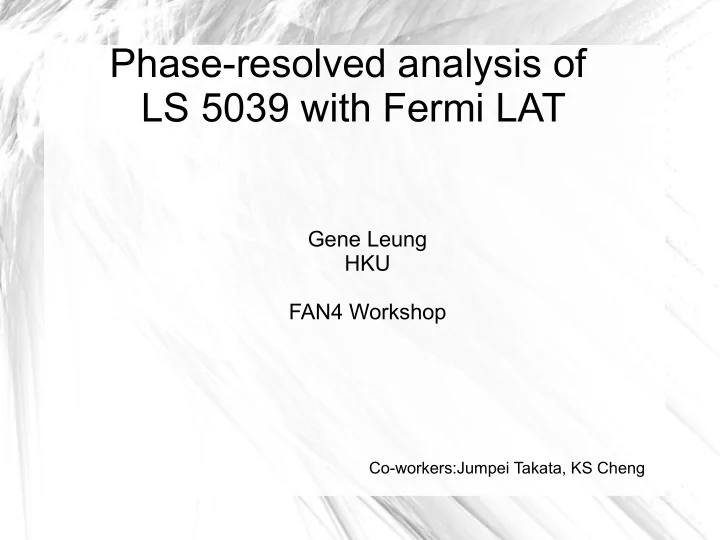

Phase-resolved analysis of LS 5039 with Fermi LAT Gene Leung HKU FAN4 Workshop Co-workers:Jumpei Takata, KS Cheng
LS 5039 ● High-mass X-ray binary ● One of the few HMXBs detected at both GeV and TeV energies ● Consists of an O6.5V star (~28 M Sun ) and a compact object (>~1.8M Sun ) ● Nature of compact object undetermined ● Black hole? Neutron star?
Orbital configuration Casares et al. Aragona et al. Sarty et al. Superior conjunction ~0.05 (2005) (2009) (2011) ~0.65 Inferior conjunction f (SUPC) ~ 0.05 e ~ 0.24-0.35 f (INFC) ~ 0.65-0.72 w ~ 225 ° -237 ° Aragona et al. (2009)
Past Fermi studies ● Abdo et al. (2009), Hadasch et al. (2012) ● Spectral analysis in two broad phase intervals ● Best fitted with power-law with exponential cutoff ● Hadasch et al. (2012) found high energy (>10 GeV) emission feature
Comparison with previous studies ● Background sources: 1FGL vs 2FGL ● Data, IRFs, diffuse BG: Pass 6 vs Pass 7 ● Length of observation: 2.5 years vs 4 years ● Finer binning of orbital phase
Data set ● Time span: 2008 Aug 14 to 2012 May 19 ● Energy: 0.1-300 GeV ● ROI: 20 ° x20 ° region centered at LS 5039 ● Event class: Pass 7 source ● Pass 7 source v6 instrumental response functions ● Excluded events with zenith angle < 100 degrees to avoid Earth's albedo ● Excluded events from pulse phase (0.05,0.2) and (0.6,0.75) of nearby pulsar PSR J1826-1256
Phase-averaged spectrum G = -2.07 +/- 0.07 E C = 2.76 +/- 0.46 GeV
S U P C a s t r o n A p Light curves F C I N 0.1-300 GeV s t r o n P e r i a P C S U o n A p a s t r I N F C
Light curves 1-100 GeV n n n o o o C C r r r C t C t P P t s s s F a F U U a a N i N p S r S p e I A I A P 0.1-1 GeV Modulation more prominent in low energies
S U P C Hardness ratio o n A p a s t r F C I N s t r o n P e r i a P C S U A p a s t r o n C I N F
Phase-resolved spectral analysis ● Define 3 equally spaced phase intervals: – [0.83,1.17] (periastron and INFC) – [0.17,0.5] – [0.5,0.83] (SUPC) ● Perform likelihood fits in each phase intervals, fixing spectral parameters of sources more than 5 degrees from the target
Division of orbital phase S U P C A p a s t r o n F C I N a s t r o n P e r i P C S U s t r o n A p a N F C I
G = 1.71 +/- 0.14 G = 2.18 +/- 0.07 E C = 2.12 +/- 0.56 GeV E C = 2.06 +/- 0.42 GeV SUPC Reduced flux in ~0.1-0.3GeV ● compared with previous studies G = 2.09 +/- 0.13 (improved IRFs, diffuse E C = 3.87 +/- 1.50 GeV background, etc) Enhancement in ~0.1-1GeV for ● 0.83< f <1.17, i.e. SUPC and periastron High energy component most ● INFC significant in 0.17< f <0.5
Theoretical model (Takata et al. 2013) ● Pulsar scenario ● Magnetospheric emissions ● IC of stellar photons and cold-relativistic pulsar wind ● Termination shocks at two emission regions
Theoretical model fitting SUPC 0.5< f <0.83 ● Modulation of IC emissions from cold- relativistic pulsar wind in ~0.1-1 GeV ● IC of shocked pulsar INFC wind at ~>10 GeV
Theoretical model fitting n C C o P F r t U N s S a I p A
Summary ● Spectral analysis for 3 phase intervals ● Orbital modulation in 0.1-1 GeV due to cold pulsar wind ● High energy emissions of shocked pulsar wind ● Orbital modulation of spectral hardness
Recommend
More recommend